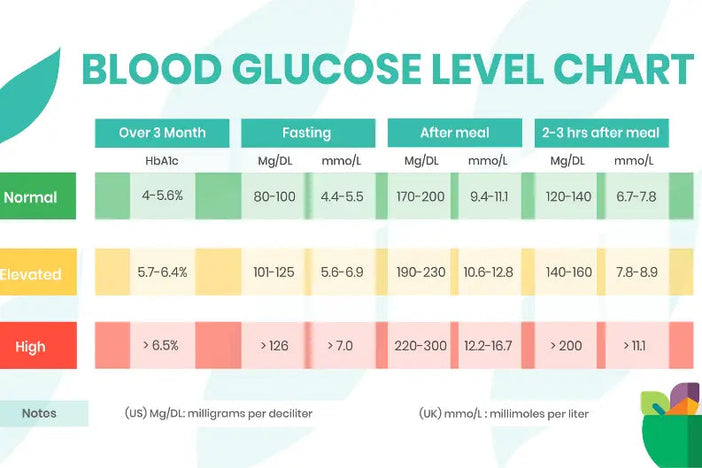Normal Glucose levels After Eating. What Is Acceptable And What Is Not?

We understand, your ability to maintain normal blood sugar (glucose) levels is reduced. Either because you do not produce enough insulin to let glucose into cells or because cells no longer respond to its effects (insulin resistance). As a result, glucose cannot leave the bloodstream to enter muscle or fat cells. Glucose is burned as fuel or converted into energy stores for future use, instead, it builds up in the circulation.
Postprandial blood sugar
Scientists now know that the rise in blood glucose that occurs an hour or two after eating – known as postprandial hyperglycemia – is particularly harmful. Preprandial refers to high blood sugar levels (between 70-130 mg/dl)before a meal and postprandial means the spike (less than 180) is occurring after a meal. The way that food affects your blood sugar levels after eating is known as its glycemic index.
These rapid sugar spikes attack the lining of arteries and small blood vessels to hasten the hardening and "furring up" the arteries (atherosclerosis). As a result, high postprandial blood sugar is linked with an increased risk of diabetes complications. Such as heart attack and stroke, as well as damage to the eyes (which can lead to blindness), kidneys (which can lead to kidney failure), and peripheral circulation (which can lead to leg ulcers and erectile dysfunction for example).
Even if you have good control and you are at target levels, you can still have postprandial hyperglycemia. In one study involving 3,284 people with type 2 diabetes, a postprandial blood glucose value greater than 8.89 mmol/l (160mg/dl) was found at least once in 84% of those taking part. This study suggested that factors that increased the likelihood of having high glucose levels after eating were -
- longer duration of having diabetes,
- age of a person,
- raised blood fat levels,
- high blood pressure,
- and not being obese.
Taking sulfonylurea medications (eg glibenclamide, glipizide, glimepiride) was also associated with greater glucose swings after meals.
A two-hour postprandial glucose test measures blood sugar exactly two hours after you start eating a meal. This test is most often done at home when you have diabetes. It can help you understand if you are taking the right amount of insulin with meals.
When diagnosing impaired glucose tolerance, you may be asked to undergo a two-hour oral glucose tolerance test if the result of your fasting blood test is borderline (for example, between 6.1 mmol/L – 6.9 mmol/L) to see what happens to your blood glucose level after consuming a known amount of glucose.
Oral Glucose Tolerance Test- How is blood sugar measured?
An OGTT is generally carried out first thing in the morning after you’ve not eaten for between 8 and 14 hours) – this ensures your blood sugar levels are not affected by a recent meal, although you may drink water. First, a baseline for fasting blood sugar level is taken, then you are asked to drink a solution containing 75g glucose dissolved in 250-300ml water, which must be consumed within 5 minutes. You then remain inactive for two hours, without smoking, and a further blood sample is taken exactly two hours after the glucose drink to measure your blood glucose level.
In someone without diabetes, blood sugar levels normally go no higher than 7.8 mmol/L (140 mg/dL) two hours after having the drink.
If someone’s two-hour average blood sugar level is between 7.8 mmol/L (140 mg/dL) and 11.1 mmol/L (199.8mg/dL), they have impaired glucose tolerance and are at increased risk of developing diabetes in the future although diet and lifestyle changes can help to avoid this.
Diabetes is diagnosed if your blood glucose level is 11.1 mmol/L (199.8 mg/dL) or higher two hours after drinking the glucose solution.
These blood sugar cut-off points are based on a large body of research that shows that damage to the body starts to happen in the early stages of type 2 diabetes, even when fasting glucose and HbA1c are within normal ranges. Diabetes studies have even shown that 1- or 2-hour levels during a glucose tolerance test were better predictors of cardiovascular risk (of heart attack or stroke) than either fasting glucose or HbA1c levels.
This ‘silent’ postprandial hyperglycemia is causing macrovascular complications such as myocardial infarction or stroke as well as microvascular complications at these levels so that damage due to hyperglycemia has already begun. It is therefore important, for people with diabetes, to reduce blood spikes after eating as much as possible.
What is an acceptable blood glucose level after eating? What are the ideal blood sugar levels and what level of sugar is dangerous?
A good general goal is to maintain a blood sugar level of less than 10 mmol/L (180 mg/dL) in the one to two hours after a meal. Your doctor can tell you the best number for the average blood sugar level to aim for. That number can range depending on the test that you are doing or in fact how well you are controlling your glucose levels.Extremely high blood sugar levels can be unsafe.
TARGET BLOOD SUGAR LEVELS (Age 20+)
How postprandial hyperglycemia damages circulation?
Glucose is a reactive molecule that attacks and attaches itself to proteins in circulation. For example, glucose can react with the red blood pigment, hemoglobin, to form glycosylated (or glycated) hemoglobin, which is why levels of HbA1c are used to assess how good your glucose control was over the previous 6 to 12 weeks.
The normal range for HbA1c is 4% - 6%. For someone with type 2 diabetes and good glucose control, the level of HbA1c should be less than 6.5%. Minimizing your postprandial glucose levels will help improve HbA1c – important because every percentage point above normal increases the chance of developing complications such as eye or kidney problems by as much as 20%.
By attacking blood vessel walls, postprandial hyperglycemia triggers inflammation and increases the production of chemicals known as advanced glycation end products or AGEs – an appropriate acronym as these chemicals are linked with premature aging. These AGEs and oxidized fats (lipid peroxidation products) in turn affect the production of nitric oxide (NO) which is needed for blood vessels to dilate. As a result, arteries are less able to dilate when needed. This contributes to a rise in blood pressure.
Overcoming morning spikes in glucose levels
A regular blood glucose test is a crucial tool for managing your diabetes. Some people find their glucose levels are high in the morning even before eating, and they rise even higher after breakfast. Having a high blood sugar level in the morning is known as the dawn phenomenon and may be pronounced in as many as one in two people with diabetes.
The dawn phenomenon is due to our natural biorhythms in which production of insulin hormone is suppressed during sleep, and levels of other hormones (growth hormone, glucagon, and cortisol) rise, which stimulates the liver to make new glucose.
For people without prediabetes (metabolic syndrome) or diabetes, the rise in glucose is minimal as insulin is released to ensure glucose levels stay within normal limits. For those with diabetes, insulin production is either reduced or cells no longer respond to it. So that makes blood glucose levels stay higher than normal.
Also, in some people with type 2 diabetes, the liver does not respond to signals telling it there is plenty of sugar within the circulation and it continues to churn out new glucose.
If your glucose levels are raised in the morning it is still important to eat a healthy breakfast – do not skip this important meal. Select foods that have minimal impact on blood glucose levels, and talk to your doctor to see if your treatment needs adjusting.

How to reduce postprandial hyperglycemia and how to manage after-meal spikes?
To reduce postprandial glucose, it is important to choose healthy options for yourself throughout the day. Make sure to:
- Eat little and often - six small meals a day is better than having three large ones;
- Select foods with a lower glycemic index - beans, whole grains, vegetables, fruit, lean meat, fish, nuts, seeds, olive oil, eggs, and dairy products;
- Avoid - white potatoes, white bread, white rice, sweetened breakfast cereals, biscuits, cakes, and other foods containing white flour and sugar;
- Drink a glass of water - with each meal to help you feel full and eat less;
- Stay active - for at least 20 minutes after eating – go for a walk or at least avoid sitting or lying down after a meal.
How long after eating does blood sugar return to normal?
Everyone is different.
If you’re diabetic you should know how long it takes you to return to a normal level after a meal. Factoring in:
- Your beginning blood glucose;
- How early you take supplements, medication or insulin before a meal;
- How many supplements, medication or insulin do you take;
- How many and the type of carbs you eat.
Knowing comes from your experience. Join our community and share your experience with us.




